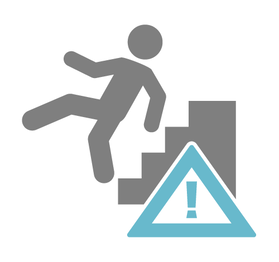- "A simple thing can change your life—like tripping on a rug or slipping on a wet floor." Prevent Falls and Fractures from the NIH, National Institute on Aging, offers comprehensive yet simple to understand guidelines for the older individual.
- A recent post from Harvard Health Publishing, Harvard Medical School, reported that “An older adult is treated in the emergency room for a fall every 11 seconds."
- "Falls are a leading cause of death among older adults," according to the Centers for Disease Control and Prevention, "An older adult dies from a fall every 19 minutes."
Falls are particularly hard to study — and prevent — because no two falls are the same. Each fall occurs from the unique interaction of the person’s balance, the task they were performing just prior to the fall, and the ever-changing environment in which they were moving. All these things make it difficult to pinpoint the exact cause of a particular fall, and nearly impossible to uncover commonalities across all falls suffered by older adults.
The complexity of falls may be the key to their prevention. It is now quite clear that fall-prevention strategies that target just one factor with a well-known link to fall risk, such as muscle weakness, do not effectively reduce falls in older adults. Instead, researchers now believe that in order to keep older adults safe and free from falls over the years, interventions must continuously target multiple individual and environmental factors.
The complexity of falls may be the key to their prevention. It is now quite clear that fall-prevention strategies that target just one factor with a well-known link to fall risk, such as muscle weakness, do not effectively reduce falls in older adults. Instead, researchers now believe that in order to keep older adults safe and free from falls over the years, interventions must continuously target multiple individual and environmental factors.
The good news is that falls in your home can be avoided. If you’re aging in place and want to take action to prevent falls, try one or more of these tips:
- Make exercise part of your daily routine
- Stay mentally active
- Review your medications
- Have your vision and hearing checked regularly
- Conduct an annual home inventory
Implementing multiple preventive measures early and evaluating them often can facilitate your mobility, reduce your chances of losing balance, and help maintain your quality of life for years to come.
At the VNA of Northern New Jersey, your health and safety at home is our top priority. If you need help with fall prevention in your home, don’t hesitate to contact us.
For 123 years, the Visiting Nurse Association of Northern New Jersey (VNANNJ) has been committed to improving the health and wellness of our community. We believe it is important to provide our neighbors with resources that will help them live happier and healthier lives.
















